| Please access the following URL if you want to secure using SSL. All pages in the site will be secure pages. |
https://secure02.blue.shared-server.net/www.fish-food.co.jp/message english 8.2023.html |
Welcome to FISH FOOD TIMES
Aug. 2023 issue No.236

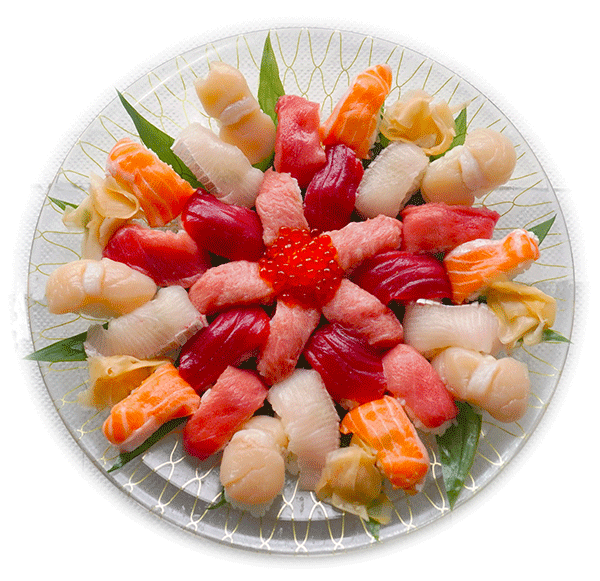 Omnidirectional Sushi Hachimori
Omnidirectional Sushi Hachimori
Omotenashi
The other day, in mid-July, I entertained an important customer. Therefore, I decided to treat the customer to sushi and sashimi, and what I made at that time is the opening image of this month's issue.
August is the Obon holiday season, and it is thought that there will be more occasions when a large number of people gather in each household. Demand for sushi and sashimi in large containers should increase in preparation for dinner parties at home. In line with such timing, last year's August 4th issue of FISH FOOD TIMES No. 224 proposed "Omotenashi Syunsen assorted sashimi". In the August issue of this year, I would like to use the Sushi Hachimori that I created in July as the theme, and make it the theme of "Hospitality Sushi Hachimori." In particular, I would like to consider and describe the contents, focusing on "what should be the shape and arrangement of containers used for sushi when entertaining?"
The word "Hachimori" is not national
The author was born and raised in Fukuoka, Kyushu. I lived in Tokyo for 7 years, including when I was a student. I am, so to speak, one of the country people. I have called the sushi and sashimi served in large containers prepared at home during the Bon festival and New Year holidays in the Kyushu region Hachimori. Embarrassingly, I thought that the word "Hachimori" was definitely used all over the country, but it seems that it is not actually used all over the country.
After a little research, it seems that in Kyushu, the word is generally used in Fukuoka, Kumamoto, and Saga, but there are regional differences in the use of this word in Nagasaki, Oita, Miyazaki, and Kagoshima. And it seems that the word hors d'oeuvres is common in Okinawa, not bowls. But what was it called in the old days, before the introduction of the French word Hors-d'oeuvre? Looking at the red lacquerware container for the Okinawan court dish Tundabun (Tondobon), I think that this is definitely not an hors d'oeuvre, but a Hachimori of Utu imuchi (hospitality).
Outside of Kyushu, Ehime Prefecture seems to often use the word 'Hachimori', and it seems that the word 'Moribachi' is also used. In Kochi Prefecture, the famous Sawachi dish seems to be placed in the same position as Hachimori. However, it seems that other regions do not use special expressions to describe a large plate of sushi or sashimi. I dare say that even if 'Funamori' exists, the word 'Hachimori' doesn't seem to be used to express the position of the special meaning.
Even so, I don't think it's at all appropriate for Japanese food culture to enclose sushi and sashimi served on a large plate with the French word Hors-d'oeuvre. It seems that terms such as shidasi bento and kaisekizen are similar to Hachimori, but it is understandable that such terms are used in Japanese cuisine and restaurants. However, I think that using this word for fish shop sushi, for example, is a little different.
The word ``Hachimori'' is the most appropriate word for a platter of sushi and sashimi, and the author, who wants to make the word ''Hachimori'' a common language throughout the country, is convinced of this wording in a sense. I apologize to those who are unfamiliar with this term, but I would like to continue using Hachimori's words below.
Sushi hachimori container shape and arrangement
In general, there is the word assorted sushi plate, but how should this word be used differently from sushi hachimori? Regarding the assorted sushi plate, I think there is no problem with the expression sushi assorted sushi plate from 1,000 yen to around 3,000 yen. However, if this is a product with a selling price of 5,000 yen or more, I feel that the same name of assorted sushi plate will cause problems.
The halfway selling price range of 3,000 yen to 5,000 yen is considered to fall into either of these cases depending on the size of the container and the contents of the dish. For the time being, I will use the word "Hachimori" to refer to products priced at 5,000 yen or more, which are not embarrassing to serve at celebrations and hospitality occasions.
For example, this is a 40-piece serving of raw bluefin tuna, including large fatty, medium fatty, and red meat.
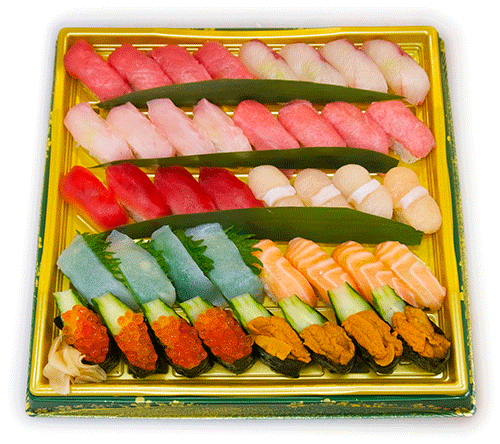
I think that the way of thinking about setting the markup ratio will differ depending on the company or store, so I would like to refrain from setting an estimated selling price. Probably, the selling price will definitely be set at 5,000 yen or more.
I would like to describe this kind of product as "Sushi Hachimori" rather than assorted sushi plate. And, judging by the author's opinion, the image below is an "assorted sushi plate."
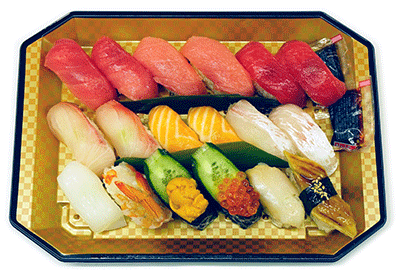
In other words, the sushi with 40 pieces above is sushi hachimori because it is supposed to be eaten by two or three people. However, the 18-piece sushi below is an assorted sushi plate, even though the contents are gorgeous, because there are 6 types of each fish and one piece, and it is commercialized as a volume for one person.
The contents of the above two products are not much different, and the only difference is that they are lined up horizontally in 5 or 3 rows. Although there is a difference in quantity due to the size of the container, basically this size makes the difference between sushi hachimori and assorted sushi plate. By doing so, we envision the difference in dining tables where these products will be placed.
In other words, the difference is whether the container is large or small, and whether the quantity of contents is large or small, even if this becomes 60 pieces like the image below, there will be no big difference in how to make it.
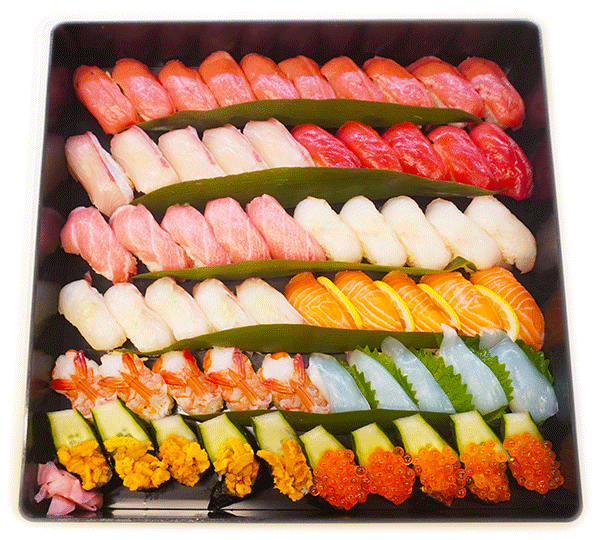
The selling price of this 60 piece sushi hachimori will be around 10,000 yen, but there is no big difference in how to make it from the 18 piece assorted sushi plate. These are the basic patterns for fish shop sushi, and many companies have them in their manuals. With this method, you can arrange the sushi in order mechanically without thinking too much. Therefore, it should be welcomed by the female part-timers who are mainly in charge of the work, saying, "The size is large, but the presentation is not so difficult."
However, when it is placed in a slightly modified container called a kadomaru, as shown in the image below, it reacts a little differently. When it comes to 66 pieces of hachimori in a kadomaru container like this, there are many differences in how it is served depending on the person. and since the sense of uniformity of the product fades and the way the sushi is served is sometimes disturbed, it is often disliked to use such a container and create a manual as a product.
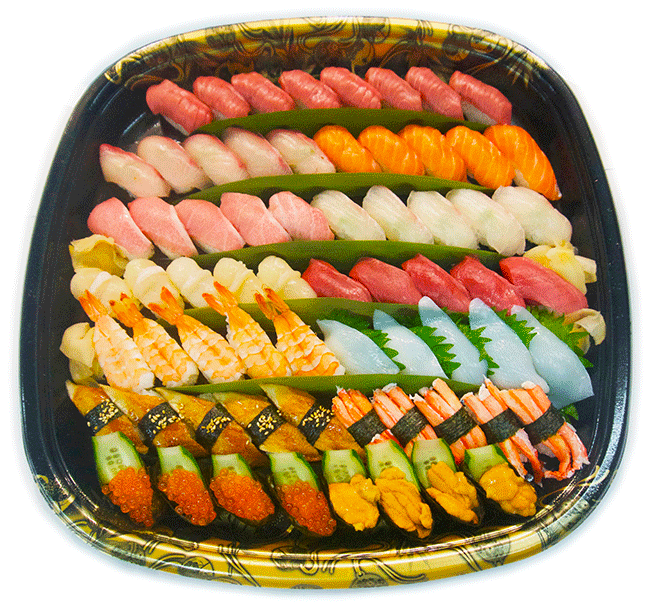
The reason why this product is disliked is because of the arrangement of this product, 8 pieces of one type are arranged horizontally in the first row. And from the next one, it's a little complicated to have 2 types of 5 pieces in 5 rows and finally 2 types of 4 pieces in a row. This is because kadomaru is a half-deformed container, so it is difficult to arrange 10 pieces in a horizontal row on the top and bottom, and the number of pieces must be arranged in a row of 8 pieces.
Advantages of round container
Comparing the above 4 types of assorted sushi plates, from the 18-piece assorted sushi plate to the 66-piece sushi hachimori, there is no change in the fact that the sushi is basically arranged in a horizontal row facing a certain direction. These have a front and a back, which is convenient for customers who will sit in front of them when they are placed on the dining table. However, the back side of the hachimori is not a very good place for those who have paid to prepare these things.
If you imagine a large dining table where brothers and sisters and relatives gather at a table such as Obon, you probably want to avoid such a front and back side if it is possible to avoid it.
As a way to deal with and solve this problem, there is a method like the image below.
.gif)
One of them is to arrange sushi radially on a round plate like this. It is sushi hachimori with 48 pieces of 13 kinds, but with this, there is no back or front. With this arrangement in this round container, all directions are "front", apart from whether the sushi you like is on the front or on the far side.
For example, there is an example of serving in a horizontal row on a round plate as shown in the image below. However, it cannot be said that this arrangement makes the best use of the shape of the round plate. In this case, it is necessary to greatly change the number of pieces of nigiri sushi to be arranged in the upper part, the lower part, and other places, and it is much more difficult than the kadomaru container to balance the arrangement.
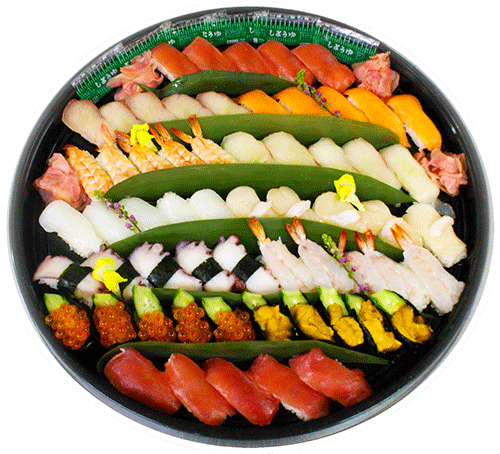
This round plate sushi hachimori is also the same as the image I have introduced so far, it is one of the products created by the author, and the creation date information was April 2012, 11 years ago. If I remember correctly, it was when I was asked to create a sushi merchandising model for the delicatessen department, not the marine products department.
When I evaluated the workmanship of this completed product in my own way, unfortunately I didn't think it was very good. 60 pieces of sushi are too many in a container of this size, and I cannot avoid the impression that the nigiri sushi was packed into the container with a little overwork. For this reason, there are parts where the shape is distorted, and where it should be a horizontal straight line, it is strangely distorted and curved, and the overall uniform balance is lost.
There is almost no point in using a round container if you are going to put things in a horizontal row in a certain direction in a round container like this. A simple rectangular container is definitely easier to shape and looks better. In other words, if you use a large round container for serving, you should be able to understand that you can enjoy the benefits of the round shape by arranging the nigiri sushi radially.
Radial and all-directional serving
Assuming that the total number of people around the dining table is 5 adults, I decided to make sushi hachimori by arranging nigiri sushi radially in a round container that does not have a front or back. One of them is the image below, which is the opening image of this month's issue.
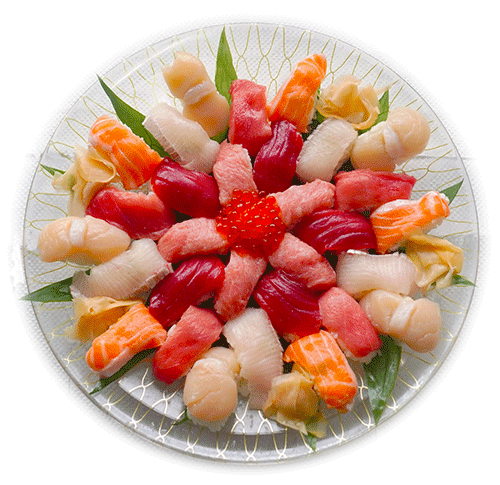
The container is a round plate made of transparent plastic with a diameter of 33 cm. Since this container is shallow, it is likely that it is mainly intended for serving thinly-sliced puffer fish. It is the same as the one I used last year in FISH FOOD TIMES October issue No.226 Tiger puffer sashimi.
Before serving the nigiri sushi, first cut a leaf of kumasasa in half lengthwise and spread it radially. This round plastic round plate is just a thin gold pattern on a transparent background. It has a refreshing feeling but lacks color, so I decided to lay a leaf of kumasasa for the purpose of giving a change of color.
The method of serving nigiri sushi is the same as the sushi hachimori with 48 pieces arranged on the round plate posted earlier, but this is served from the outside and then proceeded in order to the center. However, in the case of this work, it is quite the opposite. First, 5 cans of raw tuna Ootoro were placed in the center, then raw tuna lean meat was placed between Ootoro and Ootoro, then medium fatty tuna was sandwiched between Ootoro and tuna lean meat, and so on. Next, amberjack belly body was placed between Cyutoro and tuna lean meat, raw salmon was placed between amberjack and medium fatty tuna, and scallop adductor muscle was placed between medium fatty tuna and amberjack on the opposite side with a similar gap. The total is 30 cans with 6 kinds of 5 pieces each. Finally, as a finishing touch, sushi hachimori is completed by placing a generous amount of salmon roe on top of the perfectly round sushi rice.
It sounds complicated when you explain it in words, but it's not. In short, it's just a matter of repeating ``putting a different kind of nigiri sushi between the same kind of nigiri sushi''. It's not random, but it has a solid rule, so if you have a sample such as a photo, it's not so difficult for part-timers to reproduce.
And this dish alone is not enough for 5 people, so I tried making a similar dish with a diameter of 30 cm using a different fish. That is the image below.
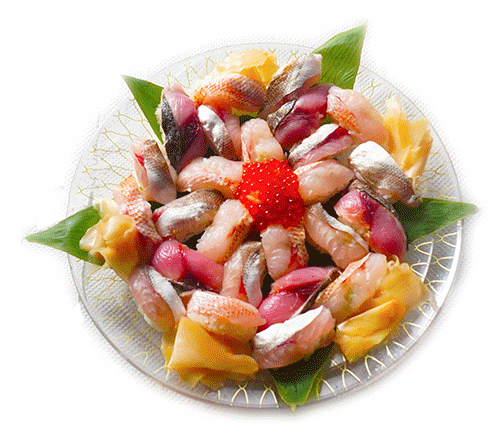
The size of the container is one size smaller, so it became a 25-piece serving. The serving method is basically the same as above. The only difference is that it's impossible to make the outer part radial, so it's placed at a slight angle. In addition, blackthroat seaperch and red barracuda are repeated twice with 5 pieces each, striped bonito is only 5 pieces, and 3 types of fish make 25 pieces of hachimori. (However, there is also one salmon roe overflowing in the middle, so it is exactly 26 pieces.)
This small container is natural fish nigiri sushi hachimori because all three fish species are wild fish. There is no guarantee that the same thing can be done on another day, but something similar should be possible. And all the fish are seared with the skin on to make sushi toppings. As a point of reflection, I seared the red barracuda after tightening it with kelp, but I felt that the texture of the skin was too much. I thought I should have added a little more effort and cut a lot of "narrowly spaced decorative knives" into the surface of the skin.
Five people sat around the dining table, and the nigiri-zushi was arranged in a radial shape on a round plate, with two large and small hachimori lined up, and there was no front or back from any position on the table as intended. I thought this method of serving nigiri sushi was the correct answer.
The difficulty of serving sashimi in a radial pattern
For the time being, I was able to make a nigiri sushi hachimori that is close to what I envisioned. However, making sashimi radially on a round plate is a high hurdle. If it is a single fish species like tiger puffer in the image below, it is already common to make thin round plates, so it can be commercialized by applying it to flatfish instead of puffer fish.
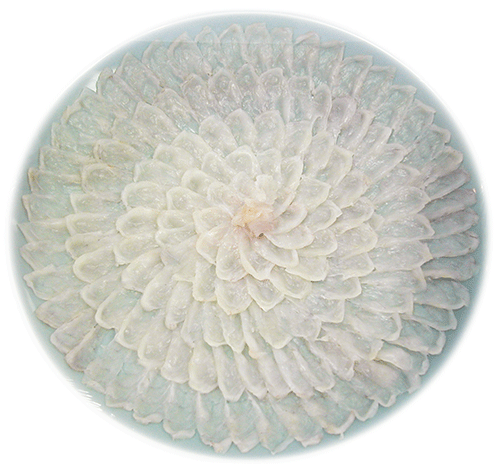
Like the usutsukuri of this tiger puffer fish, it is not easy to arrange everything in a uniform radial shape in terms of size, shape, thickness, direction, and three-dimensionality, and it is a world of so-called craftsmanship.
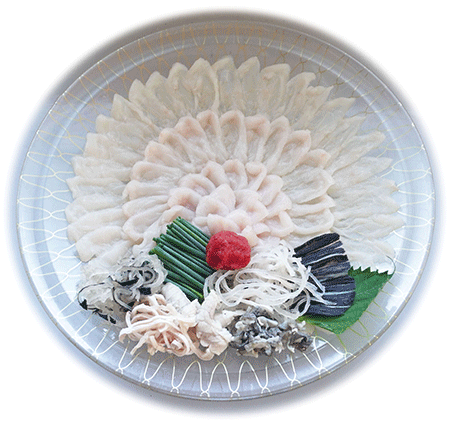
The above image is the opening image of last year's FISH FOOD TIMES October issue No.226 Tiger puffer sashimi. This interrupts the author's round shape on the way. In addition, it is intentionally not a perfect radial shape, but a shape to clarify the front. The reason is that the customer who ate this was one person, and it was not a dinner with a large number of people, so I dared to turn the face of the sashimi toward the customer.
Making a single fish species such as puffer fish into a radial shape like this, whether it is a perfect circle or an imperfect circle, is already common and not uncommon. However, it is a different story when it comes to serving various fish species radially on a round plate. In fact, I have never served more than two kinds of fish in a radial shape like puffer fish usutsukuri.
It can be inferred that this will not be straightforward just by imagining the process in the middle of making it. This is because fish differ in shape and size, and have unique characteristics such as flesh color, meat quality, and moisture content. Therefore, it is expected that it will be extremely difficult to cut and arrange them in a radial pattern like puffer fish sashimi. To put it bluntly, such a thing is at a level where we cannot help but question whether it is possible to achieve it in a good way.
The fish I purchased this time are 9 items (7 fish species): raw, large fatty, medium fatty, lean bluefin tuna, amberjack belly, raw salmon, blackthroat seaperch, red barracuda, striped bonit, and salmon roe. For example, imagine serving these on a transparent round plate. I couldn't imagine how I would do it.
I thought about it in various ways, but decided to postpone this high-hurdle task until the next opportunity. Then, I decided to make a simpler method of sashimi using the above fish, that is, to make a work with a front and a back side, and decided to make it like the image below.
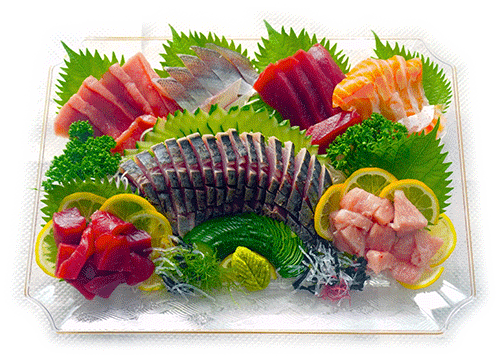
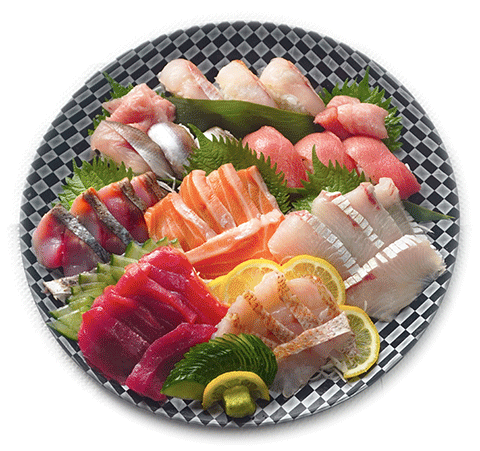
After making round plate nigiri sushi hochimori, the above two works were a challenge to use up the ingredients without wasting not only the remaining fish but also rice. As a result, there were two shapes like this, and only a little more kiridashi (the shapeless end part) was left.
Luckily, as the creator of the dish, I was very happy that the four kinds of sushi and sashimi that I made were almost completely eaten up. As someone who was in charge of the cooking, nothing could make me happier than the fact that the people who gathered had almost finished eating such a large portion of food.
In the August issue of last year, I wrote that I was disappointed that about one-third of the sushi and sashimi that I had prepared for customers remained. However, in the August issue of this year, I was able to write a completely opposite result, and the author, who had spent time and money preparing the food, felt great.
Expectations for this year's Obon shopping season
By the way, in the second half of this month's issue, we have deviated from the theme of "What should be the shape and arrangement of containers used for sushi when entertaining?" However, since sashimi hachimori is also an indispensable part of the Bon festival season in August, it cannot be said that the content is completely unrelated.
I wonder when readers have accessed and read this month's issue. If you are an avid reader who will read this month's issue on August 1st, this issue's contents may be of some help as you approach the Bon sales season as a hint to boost your sales. However, if you read this month's issue after the 15th, it will be too late to help increase sales during the Bon season.
By the way, it is expected that the movement of people during this year's Bon season will almost return to the time before the corona disaster. Looking at the figures announced by JR companies, it seems that the movement of people, including people returning to their hometowns during the Obon period this year, is likely to increase by about 50% compared to the previous year. It is thought that stores located in rural areas that welcome returning customers can expect a certain amount of sales accordingly.
Sushi and sashimi should be the main sales of the fish section during Obon. In particular, sushi is very popular with men and women of all ages, and the reality is that sushi sales are almost double that of sashimi at the store of the company I am affiliated with. This trend is expected to become more pronounced during the Obon season, and it is not uncommon for fish shop sushi to account for a staggering 30% of the fishery section, and its presence is increasing more and more.
In this year's Bon Festival, the success or failure of sales at fish shop sushi should directly affect the overall success or failure of the fish section. I hope that all readers of FISH FOOD TIIMES will refer to this month's issue and lead the summer season to success.
| Please access the following URL if you want to secure using SSL. All pages in the site will be secure pages. |
https://secure02.blue.shared-server.net/www.fish-food.co.jp/message english 8.2023.html |
An opinion and the communication are to iinfo@fish food times
Date of updating 1 Aug. 2023
